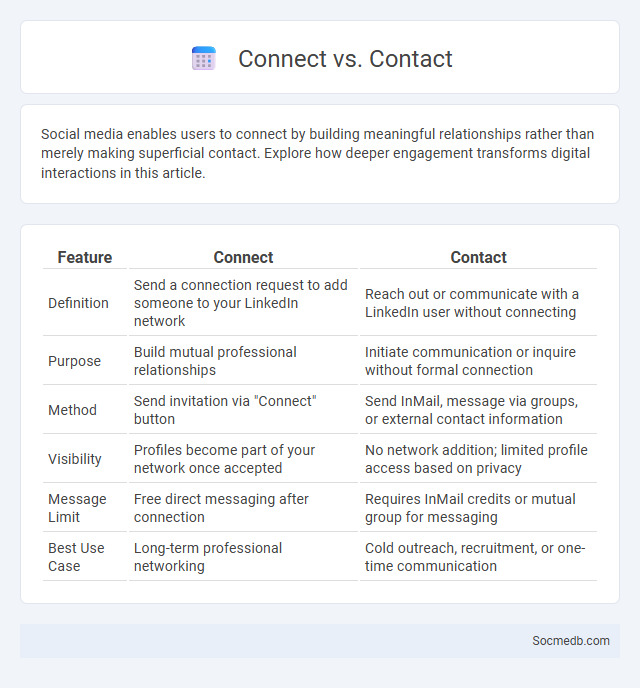
Photo illustration: Connect vs Contact
Social media enables users to connect by building meaningful relationships rather than merely making superficial contact. Explore how deeper engagement transforms digital interactions in this article.
Table of Comparison
| Feature | Connect | Contact |
|---|---|---|
| Definition | Send a connection request to add someone to your LinkedIn network | Reach out or communicate with a LinkedIn user without connecting |
| Purpose | Build mutual professional relationships | Initiate communication or inquire without formal connection |
| Method | Send invitation via "Connect" button | Send InMail, message via groups, or external contact information |
| Visibility | Profiles become part of your network once accepted | No network addition; limited profile access based on privacy |
| Message Limit | Free direct messaging after connection | Requires InMail credits or mutual group for messaging |
| Best Use Case | Long-term professional networking | Cold outreach, recruitment, or one-time communication |
Understanding Connect, Contact, and Connection Request
Understanding social media's core features helps you navigate platforms effectively by distinguishing between Connect, Contact, and Connection Request. Connect involves establishing a mutual link that allows sharing content and communication, while Contact refers to the personal details or methods to reach someone directly. A Connection Request is the initial invitation sent to another user to form that Connect link, pending acceptance to enable interaction.
Definitions: Connect, Contact, and Connection Request
Social media platforms enable you to connect with others by establishing mutual relationships through connection requests, which are invitations sent to initiate communication or networking. A contact typically refers to an individual already within your network, allowing direct interaction and content sharing. These fundamental concepts--connect, contact, and connection request--form the backbone of social media networking, fostering relationships and community building.
Key Differences Between Connect, Contact, and Connection Request
Social media platforms differentiate between Connect, Contact, and Connection Request to streamline user interactions and privacy settings. A Connect action typically establishes a mutual relationship allowing direct messaging and content sharing, while Contact often refers to exchanging basic information without full access to personal profiles. Connection Request involves one user sending an invitation that must be accepted to create a two-way link, enhancing network building and control over connections.
When to Use Connect, Contact, or Connection Request
Choosing between Connect, Contact, or Connection Request on social media depends on the nature of your relationship and communication goals. Use Connect when inviting professionals to build your network for mutual engagement, Contact to initiate direct communication or inquiries, and Connection Request to formally ask for permission to link with someone. Understanding these distinctions ensures Your interactions are relevant, respectful, and effective in expanding your social presence.
Benefits of Connecting, Contacting, and Sending a Connection Request
Social media platforms enable users to connect with professionals and peers worldwide, enhancing networking opportunities and fostering collaborative relationships. Sending a connection request facilitates direct communication, enabling quick exchange of ideas, support, and resources. This seamless contact improves visibility and access to industry insights, career growth, and personal development.
Common Platforms for Connect, Contact, and Connection Request
Facebook, Instagram, Twitter, LinkedIn, and Snapchat dominate as common social media platforms for connecting, contacting, and sending connection requests. These platforms offer various features like messaging, friend requests, and professional networking tools tailored to different communication needs. Your social media strategy should leverage the unique strengths of each platform to maximize engagement and build meaningful relationships.
Best Practices for Connecting, Contacting, and Requesting Connections
Effective social media networking involves personalizing connection requests with clear reasons for reaching out and demonstrating genuine interest in the recipient's content or expertise. Utilizing professional platforms like LinkedIn ensures targeted contact, while maintaining concise and respectful messaging increases response rates. Consistent engagement through comments and shares establishes rapport, making subsequent connection requests more authentic and well-received.
Professional Etiquette: Connect vs Contact vs Connection Request
In social media networking, understanding Professional Etiquette is crucial when distinguishing between a Connect, Contact, and Connection Request. A Connect typically refers to actively linking with someone in your professional circle on platforms like LinkedIn, signifying mutual acknowledgment. A Contact often means having saved information about an individual without formal online networking, whereas sending a Connection Request is the initial step inviting someone to join your professional network, which requires personalized communication to enhance Your chances of acceptance.
Mistakes to Avoid in Networking Approaches
Avoiding common networking mistakes on social media is crucial for building meaningful professional connections. Overposting personal content and failing to engage authentically can alienate potential contacts and reduce online credibility. Neglecting to customize connection requests and ignoring the importance of consistent interaction with industry-relevant groups undermines effective relationship-building strategies.
Choosing the Right Networking Method for Your Goals
Selecting the appropriate social media networking method significantly enhances your ability to reach target audiences and achieve specific business objectives. Platforms like LinkedIn excel for professional networking and B2B marketing, while Instagram and TikTok drive engagement in visual and entertainment-focused campaigns. Tailoring your strategy to the unique features and demographics of each platform ensures optimal engagement and measurable results aligned with your goals.
 socmedb.com
socmedb.com